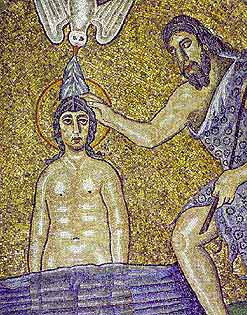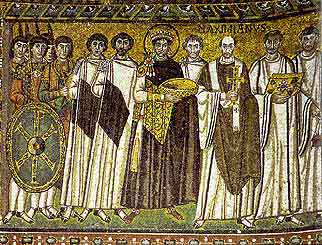CHRISTIAN IMAGES: ROMAN ART
Artistic production has been important to Christianity--in
both positive and negative ways--since the movement first spread out from its
Galilean roots into the Roman Empire. Christianity had a talent for
adapting its cultural expression to the dominant artistic idiom; this makes
sense, of course, since Christianity perceived itself as a "universal religion,"
not bound by ethnic or cultural particularity.
Some of our earliest Christian art comes from the winding
passages and chambers under Rome known as the catacombs. These were
burial chambers underneath the city, and were often decorated with meaningful
scenes from life and afterlife. A common image was that of Jesus as the
"good shepherd," guiding souls into a peaceful afterlife:
 While
the image of Christ as "good shepherd" has a foundation in the Gospel of
John,
the visual cue of "good shepherd"--carrying his lost sheep over his
shoulders--was a common image of the Roman god Mercury, who carried souls to the
underworld after death. While part of the explanation for this overlap of
visual imagery may be practical (that is, the professional wall painters
employed a set palate of images from which Christian mourners had to choose),
there is also a sense of integrating "known" cultural signs into a new,
universal system of belief.
While
the image of Christ as "good shepherd" has a foundation in the Gospel of
John,
the visual cue of "good shepherd"--carrying his lost sheep over his
shoulders--was a common image of the Roman god Mercury, who carried souls to the
underworld after death. While part of the explanation for this overlap of
visual imagery may be practical (that is, the professional wall painters
employed a set palate of images from which Christian mourners had to choose),
there is also a sense of integrating "known" cultural signs into a new,
universal system of belief.
The interiors of churches, from antiquity in the Middle
Ages, provided the most common and significant site for the elaboration of
Christian art. Images of Jesus, stories from the Bible, saints' lives, all
served to imbue the sacred space of Christian worship with deep spiritual
significance.
These complex mosaic images come from late antique
churches (fifth through seventh centuries), and are meant to invoke the
mystery, history, and materiality of Christian identity:

 This
scene of Jesus' baptism by John comes from a baptistery in the northern Italian
city of Ravenna. The baptismal font is located directly below this dome
mosaic: the Christian being baptized would be looking up at this
paradigmatic moment of initiation. Surrounding Jesus are the apostles,
signifying the continuing history of Christian identity: from Christ's
baptism to the founding of churches around the world. At left, a detail of
the mosaic showing Jesus, John, and the Holy Spirit (in the form of a dove).
This
scene of Jesus' baptism by John comes from a baptistery in the northern Italian
city of Ravenna. The baptismal font is located directly below this dome
mosaic: the Christian being baptized would be looking up at this
paradigmatic moment of initiation. Surrounding Jesus are the apostles,
signifying the continuing history of Christian identity: from Christ's
baptism to the founding of churches around the world. At left, a detail of
the mosaic showing Jesus, John, and the Holy Spirit (in the form of a dove).
The walls of churches came alive with such delicate,
light-filled images made of tiny pieces of glass. the mosaic was a complex,
expensive, and impressive art form throughout the ancient Roman world. It was
most often used as a form of decoration in the homes of the most wealthy Romans.
By bringing the brilliance of the mosaic into the Christian church, the "house
of God" was made as splendid as any Roman mansion. This intersection of
human value and divine worth sometimes allowed for less "saintly" figures to
appear on the church walls, such as this image of the Emperor Justinian (also
from the city of Ravenna):
 Here
the emperor Justinian is represented as approaching the altar of the church,
accompanied by soldiers on his right and the bishop and priests on his left.
The intersection of material culture and spiritual piety also allowed for the
integration of political and divine authority.
Here
the emperor Justinian is represented as approaching the altar of the church,
accompanied by soldiers on his right and the bishop and priests on his left.
The intersection of material culture and spiritual piety also allowed for the
integration of political and divine authority.
continue the slide show
 While
the image of Christ as "good shepherd" has a foundation in the Gospel of
John,
the visual cue of "good shepherd"--carrying his lost sheep over his
shoulders--was a common image of the Roman god Mercury, who carried souls to the
underworld after death. While part of the explanation for this overlap of
visual imagery may be practical (that is, the professional wall painters
employed a set palate of images from which Christian mourners had to choose),
there is also a sense of integrating "known" cultural signs into a new,
universal system of belief.
While
the image of Christ as "good shepherd" has a foundation in the Gospel of
John,
the visual cue of "good shepherd"--carrying his lost sheep over his
shoulders--was a common image of the Roman god Mercury, who carried souls to the
underworld after death. While part of the explanation for this overlap of
visual imagery may be practical (that is, the professional wall painters
employed a set palate of images from which Christian mourners had to choose),
there is also a sense of integrating "known" cultural signs into a new,
universal system of belief.
 This
scene of Jesus' baptism by John comes from a baptistery in the northern Italian
city of Ravenna. The baptismal font is located directly below this dome
mosaic: the Christian being baptized would be looking up at this
paradigmatic moment of initiation. Surrounding Jesus are the apostles,
signifying the continuing history of Christian identity: from Christ's
baptism to the founding of churches around the world. At left, a detail of
the mosaic showing Jesus, John, and the Holy Spirit (in the form of a dove).
This
scene of Jesus' baptism by John comes from a baptistery in the northern Italian
city of Ravenna. The baptismal font is located directly below this dome
mosaic: the Christian being baptized would be looking up at this
paradigmatic moment of initiation. Surrounding Jesus are the apostles,
signifying the continuing history of Christian identity: from Christ's
baptism to the founding of churches around the world. At left, a detail of
the mosaic showing Jesus, John, and the Holy Spirit (in the form of a dove). Here
the emperor Justinian is represented as approaching the altar of the church,
accompanied by soldiers on his right and the bishop and priests on his left.
The intersection of material culture and spiritual piety also allowed for the
integration of political and divine authority.
Here
the emperor Justinian is represented as approaching the altar of the church,
accompanied by soldiers on his right and the bishop and priests on his left.
The intersection of material culture and spiritual piety also allowed for the
integration of political and divine authority.